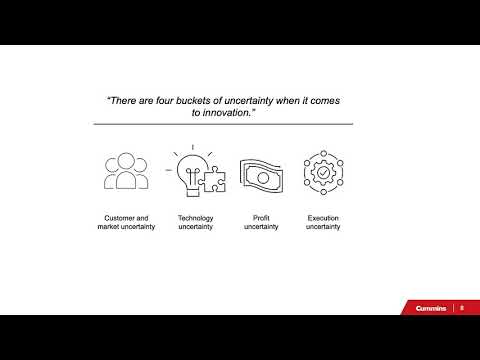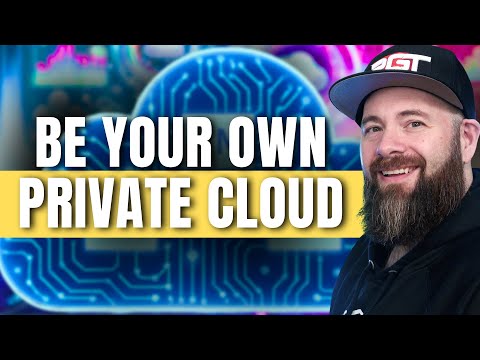Brightest Bulbs: What is Innovation?

Whether you want to advance your knowledge of emerging energy and power technologies, help your organization save money or up your innovation skills, you are in the right place. This is 'Brightest Bulbs' technology podcast and webinars by Cummins. Throughout the last couple of episodes, we have covered different energy and power technologies.
Today we will switch into the innovation process behind these technologies. We will start with basics around innovation, then cover the tension and uncertainties around it. This is Thomas Hillig, host of 'Brightest Bulbs' podcast and webinars. Today, Satish Jayaram will join us. You will hear innovation insights based on Satish's experience in bringing innovations to life and his years of experience working with partners in various industries in energy and power markets.
Satish, thanks for joining today, exciting to have you. We started each episode with a short question, and we have learned a lot about previous participants through this question. What is a personal life experience that got you excited about innovation, Satish? Thanks, Thomas.
I'm so glad to be here and thank you for the opportunity. I've been a fan of your work, Thomas, and that includes reading your microgrid journal, whenever that came out. It's a great question. I started to work when I was in high school, a little earlier than most people, and I remember I may have been about 18 or 19 years old, and I took on a job selling pagers for a telecom company in India. Some of your listeners may be too young to know what pagers are, and I might be aging myself here.
But remember, this was India in the early 1990s, where middle class households were lucky if they had a rotary phone. So along came this really cool technology that didn't require people to have to wait five to seven years to get a rotary phone. And here was my first-hand experience watching an entire society getting hurled into the digital era. And it happened in a matter of three to five years. And it was really cool what technology and innovation could do to society.
And that kind of got me interested in the space. Okay, I always thought you were much younger, Satish! Let's start with the basics. What does innovation mean? At times, I feel it is loosely thrown around as this super cool thing. What would you say innovation is beyond the initial jazz and the excitement many of us think of.
Gosh, I'm really sorry to break it to our listeners. Innovation is not jazzy or exciting, nor is it localized to one part of the world. As a practitioner and having lived in three continents and being fortunate to have watched innovation play out in the energy and power markets, I would say innovation is a lot more of a disciplined, rigorous process that builds on good ideas to deliver outstanding customer solutions. As you can imagine, for a global company like ours, that operates in 180 countries, in over 2,000 customer segments, it is crucial to have a clear and disciplined approach to innovation.
Whether that involves bringing digital solutions to customers that improve productivity at mine sites around the world or, for that matter, enabling distributed fuel-cell technologies for data centers to lower carbon emissions and a whole host of others that I could name. Ultimately at the core, it is about nurturing a culture of innovation for our customers and harnessing the best ideas and putting those ideas through a rigorous process. A quick follow up on that, Satish. How would you differentiate innovation and R&D? Yes, it is a common misnomer that people often use those two interchangeably. They are, in many ways, two sides of the same coin, and each needs the other. And so in terms of R&D, we do some cutting-edge work.
It's amazing work around emerging science that shows up in our products and delights our customers every day. Innovation is looking at the same customer problem and the market, but looking at it much more holistically, and that includes technology, but it also includes things like, what might the business model be for that technology? And how is that changing? How is customer behavior changing? What does the ecosystem today look like and how the ecosystem changing? So as you can imagine, it is a broader perspective than purely the technology element, which, don't get me wrong, is really crucial and important. Here, leveraging and managing the interconnectedness between R&D and innovation can be a powerful asset for any company. And on the flip side, when those two stay disconnected, companies lose tremendous value.
Let's switch to what's... why innovation? Many of our listeners work in corporations. They might be leading businesses, influencing executive decisions, overseeing facilities, designing power systems, or they're responsible of environmental and energy efficiency efforts. For those of us that work in a corporation, how do you see innovation contributing towards a corporation's sustainability, Satish? Thomas, that is such an important question. Sustainability is our generation's version of the Industrial Revolution. I don't mean to be hyperbolic.
There is a definite tipping point, and whether we are in it or headed close to it, it is something that will impact operations, governments and societies at large in a very real way. And it is doing so already. For example, in 2011, under 20 percent of S&P 500 companies published a sustainability report, and it's really heartening to know today only 14 percent of S&P 500 companies don't publish one. At Cummins, we view this as both an opportunity and something that is closely tied to our core values. We are applying both the capital 'I' of Innovation and the small 'i' of innovation to this challenge, meaning top down and bottom up innovation. We recently announced our Planet 2050 initiative, along with even more aggressive 2030 targets and these are incredibly aggressive targets, for example, one of which is to reduce our in-field product greenhouse gas emissions by something like 55 million tons, or, for that matter, enabling customers' success through carbon neutral technologies.
This will require innovation at all levels of the organization, from the work in our new power business, which includes investments in battery technology and hydrogen and lowering emissions and even in our core business, which includes lowering emissions in our engine technology. And, for example, that's an area we've done some tremendous work over the last decade or two, reducing emissions by 90 percent on engine technology. So all in all, I'm really excited at the trajectory where this is going. I wish it was faster, but I am excited to be part of it and be part of this energy transition. Satish, following up the same path, corporations and innovations. You work at a Fortune 150 company that just celebrated its 100-year anniversary last year.
It is a unique case where on one side you have the established core business built over the last century. On the other side, there's the need to innovate, to get ahead within and beyond the core. This friction between innovating within the core versus beyond the core could also resonate with many of our listeners that work in other established corporations.
How do you see this tension between innovating within the core versus innovating beyond the core playing out? I wish I could say there is no tension between the core and beyond the core, but that would not be true. There always needs to be some healthy tension between innovating in the core and beyond the core, and I think that's really important. And that's sort of how you stay relatively progressive around change and innovation in the company. The intensity, obviously, in the core versus beyond the core will vary based on the industry you're in.
So, for example, the disruption from new technology and a change in dominant design in mining engines, let's say, may be very different than the change in dominant design in a digital technology. At Power Systems, we think of innovation through the lens of a portfolio. It is a very diverse business that serves about a dozen end markets that are all on different clock speeds, right, so our power generation business and our standby generator business is of a different clock speed than, let's say, marine or mining or defense and so on and so forth. As a result, it's not always a simple trade-off between core versus non-core investments. We manage and actively attempt to balance this portfolio based on the sector and the segment shifts, exogenous factors, techno-economic viability of a certain technology, and this is the rigor and discipline that I was referring to earlier. And there are clearly hard trade-offs.
So, all in all, all this means looking at our investment portfolio and ensuring there is sufficient balance between core, R&D, long-term ecosystem innovation. While this is not an easy task, I find it rather encouraging that this healthy tension exists and it forces us to be really thoughtful. And the way we do that ultimately is through our stakeholder model, which is looking at it from the lens of customers, our employees and the capabilities we have, shareholders and ultimately the community, and how do impact the community? Satish, it is an exciting time in terms of all of the new technologies and innovations we see in the energy and power sector. Innovations also bring uncertainties, especially around how a change in dominant design might occur.
What are some practical examples on how listeners can think about uncertainty? Yes, changing dominant design is definitely an uncertain exercise. And if it was certain, then we are all kidding ourselves. I'll give you an interesting tidbit to illustrate the point. Thomas, you may know this very well, the first electric car was invented in the late 1800s by a company called Baker Electric, not many people might know about that.
They used batteries, nickel and zinc batteries, and it achieved just incredible range for that time. Remember, it's late 1800s. A 100-mile range was what they were experimenting with. And if one were to go and bet on that being the dominant design 100 and some years ago, it would have been a bad decision, right? The way I think of the risk and the way we think of risk around innovation and the change in dominant design is to think about it in the context of four buckets. What are those four buckets of uncertainty? So there is definitely customer and market uncertainty. There's technology uncertainty, and in many cases, when there's real area-breaking innovation, there's likely this challenge around profit uncertainty.
And then, ultimately, the uncertainty of the inability to execute on the innovation, are the four pockets. And what we try to do is constantly evaluate ideas objectively against this risk framework, as well as run experiments to prove or disprove the perception from reality. By nature, innovation is forecasting something in the future, and therefore nobody can predict the outcome. All we can do is design and test for it, and that's what we try to do. Now I'm very curious, Satish. Could you elaborate a little bit more on customer and market uncertainty and execution uncertainty? Sure, I mean, there's a whole host of things that we ought to think about when we talk about customer uncertainty and execution uncertainty.
With customer uncertainty, I think the ultimate question is will the dog eat the dog food, right? Will this product or technology or solution, solve a customer's problem, and does it do it in a manner that is meaningful and broad based that creates a market or a market could be leveraged, right? And there's a whole host of ways to experiment, test, and validate customer and market uncertainty, depending on the industry you're in. But ultimately, it is trying to figure out is there a market? And if there is a market, how broad based is that market and how well does that solution, solving that problem in that market of all those customers? The execution uncertainty, on the flip side, is largely internally focused. Do we have the capabilities, the organization, the resources, the skills, the investments to carry forward and see through a certain innovation? As you can imagine, in many of these cases, it's not a flip of a switch. When a technology innovation comes to market and is largely accepted, it takes many iterations and going through the structured method of understanding internal capabilities, metrics, resources and funding are really important to see that innovation through.
Satish, we are in a unique situation right now. The recent pandemic combined with the transforming energy sector. What is your take on headwinds and tailwinds around innovation efforts within the energy and power sector given where we are today? Yes, sure, Thomas. I mean, this is an unprecedented set of times that we are in and the pandemic has mostly pronounced the energy transition efforts and challenges in very real ways. While COVID is 'the great equalizer', it is clear the way we come out of it is going to be very unequal, especially with regard to the energy transition. For example, what is happening in Europe is very telling, as you probably...
being close to what's happening there, Thomas. The nexus of stimulus and policy efforts as a result of COVID are creating new pathways. For example, the hydrogen economy in Germany. Even in the US, we're seeing action during the pandemic on the bright side, with policies that are far more favorable towards the energy transition. Just like we saw through the financial crisis, a confluence of events led to the transition or the energy transition 1.0, I'm expecting the pace of change in trajectory to be the birth of the energy transition 2.0
as we come out of the pandemic, and a new set of confluence of events are starting to shape up. Thomas, as you may know, we have, as a result, within Cummins, continued our investment in new technologies. Whether those are things such as hydrogen and electrolyzers, to solid oxide fuel cells and energy storage as well as new engine product platforms to ensure we meet the demands of our customers today and in the near future as well as the way things are likely to shape after the pandemic. So we feel pretty good that we are organized and set up to come out of the pandemic better than where we were going into it in many respects, irrespective of where the chips may fall and it is clear that they will fall pretty unevenly around the world. So, Thomas, you've been working...
I'm going to turn this around to you. You've been working with many of the key players in the energy and power domain. What has been your perspective in terms of headwinds and tailwinds around innovation efforts in energy and power? Regarding tailwinds, actually, I think it's very favorable that most of us agree that we work towards a common goal. 2050 objectives, we have to decarbonize our societies and our industries, and we can do a quick gap analysis and we will find out what technologies that we would call today, mature. This is not possible.
So there is this need for innovation. Everyone would agree about it, and also investment decisions are made easier if we see this common goal, and that we cannot reach it with today's technologies. Regarding headwinds, in my everyday consulting business, I pretty often see that there are companies that are excellent in engineering, they are excellent in developing new technologies, but bringing these new technologies to the market, this is where they struggle. Their culture is engineering driven, and also the situation does not occur very often when you have a technology that is developed and that you have to bring it to the market at this point.
I have to say that many of my consulting projects start late, some of them even too late to make this technology still a market success. Yes, it's really interesting, isn't it, that technology is not as much the impediment. Sometimes it's organizational culture. Yeah, no, absolutely. I agree.
This is what I very often see, the right mix also of people in the organization. Okay, Satish, let's move into the last section of today's episode and focus on the how aspect. How what you describe the framework you follow in innovation efforts? What are the few ingredients of successful innovation efforts? That's a really good question. In fact, I might just pick up from where you left off.
I think you're absolutely right, Thomas, to kind of say hey, you know, what you're seeing is organizations not set up to embrace innovation and being largely engineering-focused and not having the right culture. So I absolutely agree with you and that's probably pretty top of my list. Creating the right culture that enables innovation is really crucial, right? And a good part of that is figuring out not just by means of what culture the company might have, but it's mostly around figuring out when it comes to innovation, what does the organization value and incentivize and what do they punish? It's good sense to figure out what the culture of the organization is around innovation. The second is democratizing innovation, right? It is not a monopoly where five smart people sitting in the headquarters somewhere around the globe controls innovation and ideas.
Sometimes in large organizations where people try to do that and try to kind of centralize it, it actually does the opposite than what it needs to, which is it hampers innovation when it's not democratized. The third area that I would suggest is this notion of having the right metrics. As a company like Cummins that thrives on data and metrics and KPIs, which are really important for running the business, the day-to-day business. But when it comes to innovation, it's slightly different around how you think about metrics, right, and it's important to have the right metrics for innovation and these would be things like measuring the number of experiments versus successful experiments, or measuring the quantity of ideas and the diversity of these ideas versus purely the winning ideas, right? But those are things around metrics that enable both the culture and the ability to democratize innovation. The fourth is having a really good, rigorous process that follows a good quality ideation process all the way to outcomes.
And when I say outcomes, I first and foremost mean ensuring you create a process where you are experimenting and you're running more experiments and you're running even more experiments. That is by far the most valuable part of the process that ties us all together. Satish, which future technologies are you most excited about? Gosh, that's a tough question.
I don't know if we have enough time on this podcast for that question, but let me take a stab at it. A few that I've been following is the advent of augmented reality and virtual reality. Most of us think of it as a gaming technology and what we are finding is the applications and uses of that technology is so broad, so that's one area that I am following. Another is point of sale customization of products and technologies using 3D printing, drone delivery has finally started to get some traction, blockchain and 5G are especially enablers to new applications and new technologies.
So for example, just recently, the pharmacy chain in the US, CVS, and UPS teamed up to do prescription drug delivery in the US. Just fascinating that no one would have really thought about it a few years ago, and this is an example of COVID ushering in new applications and new uses of technology. The one that I have been following with a keen interest and a keen eye, and that's a little bit closer to home, is this inadvertent innovation lab that COVID-19 has brought to us. We saw numbers like 40, 50, 60 percent reduction in industrial air pollution as a result of COVID, making it the largest experiment of sustained nitrogen dioxide reductions.
And what's interesting about it is less around the immediate innovation that's coming out of it. And it's more to do with the data that that will bring to all of us that will give us a sense of what it might mean for society to move to a low carbon economy and let alone the impacts of what that might do for health and chronic disease reduction, and so on and so forth. So this is sort of an experiment of what 2050 is going to look like in a microcosm. Unfortunately, COVID has given us the experiment. Great, Satish.
It was very exciting to hear about your insights around innovation. For listeners that are interested to learn more about the process of innovation, any resources you would suggest them? Sure, there's obviously what I would call the present-day Bible to innovation, which is 'The Lean Startup' from Eric Reis. There are a few other resources that I think are interesting. There's 'The Disruptive Voice', which is a podcast.
There's a book that just came out by Scott Snyder called 'Goliath's Revenge'. 'Goliath's Revenge' is a book about what large corporations might do in the event of digital disruption from startups. And then another book is 'A Truck Full of Dollars' by Tracy Kidder. It's a great biography of Paul English and his journey of innovation, digital innovation. Great. In addition to Satish's suggestions, be sure to visit cummins.com podcast to find other episodes and more resources.
Thanks everyone for joining us for this episode of 'Brightest Bulbs'. Be sure to subscribe wherever you listen to podcasts.
2021-02-01 02:31


